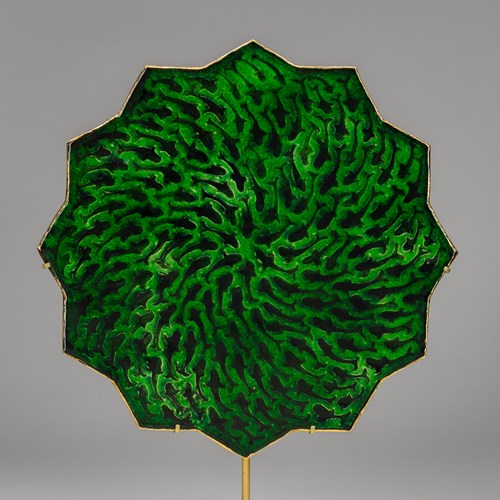Marketplace
Mother-of-Pearl Inlaid Lacquered Box
Mother-of-Pearl Inlaid Lacquered Box
Period Early 19th century
Origin Bangkok, Thailand
Dimension 19 x 21 x 15 cm (7¹/₂ x 8¹/₄ x 5⁷/₈ inches)
This lacquered wood box is elaborately inlaid with opalescent mother-of-pearl on a black background, depicting natural landscape scenes throughout the box surface. The landscape contains elements including trees, fantastic rocks, and many types of animals. One finds bulls, goats, rabbits, squirls and birds, alongside the more regionally specific animals like monkeys and elephants. Amongst the landscape are also pairs of local hunters, either hiding behind rocks or running across the field with weapons in hand. The top of the lid not only continues the landscape theme, but also contains a fortress enclosing a pillared architecture. Inside and outside the courtyard are human figured dressed in distinctively European outfits, some at leisure, while others are engaging in a conversation. There are also domestic animals like geese and a horse depicted inside the courtyard.
It is likely that the architectural depiction on the lid represent one of the factories where foreign traders used to reside. The fortified walls, as well as the small domed pavilion seems to recall the architectural design of the Bangkok forts. Built at the end of the 18th century, forts were built along the Chao Phraya River to protect the old city when Bangkok was first established as the capital in 1782. The Phra Sumen and Mahakan forts are the only two remaining forts from that period, the battlements on walls from such forts probably lend inspiration to the artist who produced the box.
The combination of lacquer and mother-of-pearl as a technique can be traced back to as early as the eighth century, and was widely used throughout China, Korea, Japan, and Thailand. In Thailand specifically, architectural elements, furniture and containers of various sorts were made in the 18th and 19th centuries for use at the court, in temples, and as diplomatic gifts.
A box produced in the same technique, but depicting trade along the Chao Phraya River in Bangkok, is in the collection of Asian Civilisations Museum, Singapore. It contains the same style of border as our example, though it has additional leaf details.
Most mother-of-pearl boxes made in this period feature floral motifs, making our example a rare item. Boxes of this type would have been used for jewellery, betel-chewing paraphernalia, cigars, or other small objects.
Reference:
Chong, Carvalho. Devotion and Desire: Cross-Culture Art in Asia, New Acquisitions of the Asian Civilisations Museum. Singapore: Asian Civilisations Museum, 2013, p.53, Cat.45.
Stock No.: A5416
It is likely that the architectural depiction on the lid represent one of the factories where foreign traders used to reside. The fortified walls, as well as the small domed pavilion seems to recall the architectural design of the Bangkok forts. Built at the end of the 18th century, forts were built along the Chao Phraya River to protect the old city when Bangkok was first established as the capital in 1782. The Phra Sumen and Mahakan forts are the only two remaining forts from that period, the battlements on walls from such forts probably lend inspiration to the artist who produced the box.
The combination of lacquer and mother-of-pearl as a technique can be traced back to as early as the eighth century, and was widely used throughout China, Korea, Japan, and Thailand. In Thailand specifically, architectural elements, furniture and containers of various sorts were made in the 18th and 19th centuries for use at the court, in temples, and as diplomatic gifts.
A box produced in the same technique, but depicting trade along the Chao Phraya River in Bangkok, is in the collection of Asian Civilisations Museum, Singapore. It contains the same style of border as our example, though it has additional leaf details.
Most mother-of-pearl boxes made in this period feature floral motifs, making our example a rare item. Boxes of this type would have been used for jewellery, betel-chewing paraphernalia, cigars, or other small objects.
Reference:
Chong, Carvalho. Devotion and Desire: Cross-Culture Art in Asia, New Acquisitions of the Asian Civilisations Museum. Singapore: Asian Civilisations Museum, 2013, p.53, Cat.45.
Stock No.: A5416
Period: Early 19th century
Origin: Bangkok, Thailand
Dimension: 19 x 21 x 15 cm (7¹/₂ x 8¹/₄ x 5⁷/₈ inches)
More artworks from the Gallery









